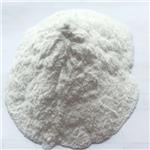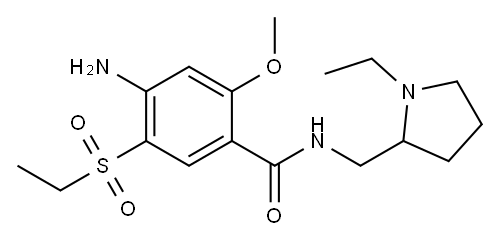Amisulpride
- CAS No.
- 71675-85-9
- Chemical Name:
- Amisulpride
- Synonyms
- 4-amino-n-((1-ethyl-2-pyrrolidinyl)methyl)-5-(ethylsulfonyl)-2-methoxybenzam;4-amino-N-((1-ethylpyrrolidin-2-yl)methyl)-5-(ethylsulfonyl)-2-methoxybenzamide;SOCIAN;SOLIAN;AmisuL;Sulamid;DENIBAN;DAN-2163;Amisulprid;AMISULPRIDE
- CBNumber:
- CB7312326
- Molecular Formula:
- C17H27N3O4S
- Molecular Weight:
- 369.48
- MDL Number:
- MFCD00866691
- MOL File:
- 71675-85-9.mol
| Melting point | 124-128 |
|---|---|
| Boiling point | 558.9±50.0 °C(Predicted) |
| Density | 1.200±0.06 g/cm3(Predicted) |
| storage temp. | 2-8°C |
| solubility | DMSO: ≥5 mg/mL |
| form | solid |
| pka | 13.73±0.46(Predicted) |
| color | white |
| Merck | 14,485 |
| InChI | InChI=1S/C17H27N3O4S/c1-4-20-8-6-7-12(20)11-19-17(21)13-9-16(25(22,23)5-2)14(18)10-15(13)24-3/h9-10,12H,4-8,11,18H2,1-3H3,(H,19,21) |
| InChIKey | NTJOBXMMWNYJFB-UHFFFAOYSA-N |
| SMILES | C(NCC1CCCN1CC)(=O)C1=CC(S(CC)(=O)=O)=C(N)C=C1OC |
| CAS DataBase Reference | 71675-85-9(CAS DataBase Reference) |
| EWG's Food Scores | 1 |
| FDA UNII | 8110R61I4U |
| ATC code | N05AL05 |
SAFETY
Risk and Safety Statements
| Symbol(GHS) |  GHS07 |
|||||||||
|---|---|---|---|---|---|---|---|---|---|---|
| Signal word | Warning | |||||||||
| Hazard statements | H302 | |||||||||
| Precautionary statements | P301+P312+P330 | |||||||||
| Hazard Codes | Xn | |||||||||
| Risk Statements | 22 | |||||||||
| Safety Statements | 22-24/25 | |||||||||
| WGK Germany | 3 | |||||||||
| RTECS | CV2308701 | |||||||||
| HS Code | 2933.99.8290 | |||||||||
| Toxicity | LD50 in male mice (mg/kg): 56-60 i.v.; 175-180 i.p.; 224-250 s.c.; 1024-1054 orally (Thominet) | |||||||||
| NFPA 704 |
|
Amisulpride price More Price(42)
| Manufacturer | Product number | Product description | CAS number | Packaging | Price | Updated | Buy |
|---|---|---|---|---|---|---|---|
| Sigma-Aldrich | BP1143 | Amisulpride for system suitability British Pharmacopoeia (BP) Reference Standard | 71675-85-9 | 50MG | $238 | 2024-03-01 | Buy |
| Sigma-Aldrich | BP1090 | Amisulpride British Pharmacopoeia (BP) Reference Standard | 71675-85-9 | 100MG | $251 | 2024-03-01 | Buy |
| Sigma-Aldrich | A2729 | Amisulpride ≥98% (HPLC) | 71675-85-9 | 10mg | $173 | 2024-03-01 | Buy |
| Sigma-Aldrich | A2729 | Amisulpride ≥98% (HPLC) | 71675-85-9 | 50mg | $656 | 2024-03-01 | Buy |
| TCI Chemical | A2450 | Amisulpride >98.0%(HPLC)(T) | 71675-85-9 | 1g | $646 | 2024-03-01 | Buy |
Amisulpride Chemical Properties,Uses,Production
Description
Amisulpride i s a n antipsychotic agent structurally related to sulpiride and sultopride. Useful in the treatment of schizophrenia, it is not, however, without EPS liability.
Chemical Properties
Off-White Solid
Originator
SESIF (Delagrange) (France)
Uses
Amisulpride is a neuroleptic agent, an analogue of Sulpiride (S689145). Amisulpride is used as an antipsychotic. Amisulpride is a dopamine receptor antagonist.
Uses
Neuroleptic agent, an analogue of sulpiride. Used as an antipsychotic. Dopamine receptor antagonist
Definition
ChEBI: Amisulpride is a member of the class of benzamides resulting from the formal condensation of the carboxy group of 4-amino-5-(ethylsulfonyl)-2-methoxybenzoic acid with the primary amino group of 2-(aminomethyl)-1-ethylpyrrolidine. It is a potent, selective dopamine D2 and D3 receptor antagonist. It is an atypical antipsychotic/antischizophrenic agent with limited extrapyrimidal side effects. It has a role as a second generation antipsychotic, a xenobiotic and an environmental contaminant. It is a member of pyrrolidines, an aromatic amine, a sulfone, a member of benzamides and an aromatic amide.
Manufacturing Process
2-Methoxy-4-amino-5-ethylthiobenzoic acid:
159 g of 2-methoxy-4-amino-5-mercaptobenzoic acid, 355 ml of water and
160 ml of caustic soda solution are placed in a flask fitted with a condenser.
The mixture is heated until the solid dissolves, then 123 g of ethyl sulfate is
added. The mixture is heated to reflux, treated with 10 ml of 30% caustic
soda solution, then heated to reflux for 1 hour. After cooling, 800 ml of water
is added and the solution is filtered. The precipitate obtained by adding 100
ml of concentrated hydrochloric acid in the presence of ether is drained,
washed with water and dried. 162 g of 2-methoxy-4-amino-5-ethylthiobenzoic
acid is obtained (yield=88%).
2-Methoxy-4-amino-5-ethylsulfonylbenzoic acid:
123 g of 2-methoxy-4-amino-5-ethylthiobenzoic acid is dissolved hot in 542
ml of acetic acid. The solution obtained is cooled to 35°C, then 185 ml of
hydrogen peroxide is added in small quantities while the temperature is raised
to 80°C. The temperature is lowered to 40°C and the mixture is kept at that
temperature for some hours and then cooled to 10°C. The precipitate formed
is drained, washed with acetic acid and dried, then dissolved in 600 ml of
water and 100 ml of 20% ammonia. The precipitate formed by adding 70 ml
of concentrated hydrochloric acid is cooled, drained, washed with water and
dried. 61.5 g of 2-methoxy-4-amino-5-ethylsulfonylbenzoic acid is obtained
(yield 42%, M.P. 95-100°C).
4-Amino-N-[(1-ethyl-2-pyrrolidinyl)methyl]-5-(ethylsulfonyl)-2-
methoxybenzamide:
81 g of 2-methoxy-4-amino-5-ethylsulphonylbenzoic acid and 297 ml of
acetone are placed in a flask fitted with an agitator, a thermometer and a
dropping funnel, followed by 33 g of triethylamine. The solution is cooled to
0°C, then 30 g of ethyl chloroformate is added drop by drop between 0° and
5°C. When the mixture has been agitated 51 g of 1-ethyl-2-
aminomethylpyrrolidine is added drop by drop between 5° and 10°C. The
mixture is agitated at 10°C then at ambient temperature. The triethylamine
hydrochloride which precipitates is drained, then the acetone is distilled. The
residue is dissolved in 600 ml of water in the presence of caustic soda solution. The base crystallizes after seeding and is drained, washed with water
and dried. When the crystals have been purified by passing them through
hydrochloride and recrystallising them in acetone, 66 g of 4-amino-N-[(1-
ethyl-2-pyrrolidinyl)methyl]-5-(ethylsulfonyl)-2-methoxybenzamideis obtained
(yield 61%, M.P. 126-127°C).
brand name
SOCIAN
Therapeutic Function
Antipsychotic
Biological Activity
Potent, selective dopamine D 2 and D 3 receptor antagonist. K i values are 2.8 and 3.2 nM respectively for human D 2 and D 3 and > 1000 nM for human D 1 , D 4 and D 5 receptors. Shows selectivity for presynaptic dopamine autoreceptors at low doses and blocks postsynaptic D 2 /D 3 receptors at higher doses. Preferentially interacts with limbic D 2 -like receptors in vivo . Atypical antipsychotic/antischizophrenic agent with limited extrapyrimidal side effects and a profile distinct from that of haloperidol and remoxipride.
Biochem/physiol Actions
Amisulpride is a highly selective D2/D3 dopamine receptor antagonist and atypical antipsychotic.
Clinical Use
Treatment of acute and chronic schizophrenia
Drug interactions
Potentially hazardous interactions with other drugs
Alcohol: may enhance CNS effects of alcohol.
Anaesthetics: enhanced hypotensive effect.
Analgesics: increased risk of convulsions with
tramadol; enhanced hypotensive and sedative
effects with opioids; increased risk of ventricular
arrhythmias with methadone - avoid.
Anti-arrhythmics: increased risk of ventricular
arrhythmias with anti-arrhythmics that prolong the
QT interval; avoid with amiodarone, disopyramide
and procainamide (risk of ventricular arrhythmias).
Antibacterials: avoid with erythromycin (increased
risk of ventricular arrhythmias).
Antidepressants: increased level of tricyclics.
Antiepileptics: antagonises anticonvulsant effect.
Antihypertensives: increased risk of hypotension.
Antimalarials: avoid with artemether/lumefantrine.
Antipsychotics: increased risk of ventricular
arrhythmias with droperidol, sertindole - avoid.
Antivirals: concentration possibly increased by ritonavir.
Anxiolytics and hypnotics: increased sedative effects.
Atomoxetine: increased risk of ventricular
arrhythmias.
Beta-blockers: increased risk of ventricular
arrhythmias with sotalol.
Cytotoxics: increased risk of ventricular arrhythmias
with vandetanib - avoid; increased risk of ventricular
arrhythmias with arsenic trioxide.
Diuretics: increased risk of ventricular arrhythmias
due to hypokalaemia.
Pentamidine: increased risk of ventricular
arrhythmias - avoid.
Metabolism
Amisulpride is weakly metabolised: two inactive metabolites, accounting for approximately 4% of the dose, have been identified. Amisulpride is eliminated unchanged in the urine. Fifty percent of an intravenous dose is excreted via the urine, of which 90% is eliminated in the first 24 hours.
storage
-20°C
References
[1] schoemaker h1, claustre y, fage d, rouquier l, chergui k, curet o, oblin a, gonon f, carter c, benavides j, scatton b. neurochemical characteristics of amisulpride, an atypical dopamine d2/d3 receptor antagonist with both presynaptic and limbic selectivity. j pharmacol exp ther. 1997 jan;280(1):83-97.
Amisulpride Preparation Products And Raw materials
Raw materials
Preparation Products
| Supplier | Tel | Country | ProdList | Advantage | |
|---|---|---|---|---|---|
| Shandong Risen-Sun Pharmaceutical Co., Ltd | +86-15552509998 +86-15621883869 | liutf@jewim.com.cn | China | 251 | 58 |
| Hebei Mojin Biotechnology Co., Ltd | +86 13288715578 +8613288715578 | sales@hbmojin.com | China | 12833 | 58 |
| Hebei Chuanghai Biotechnology Co,.LTD | +86-13131129325 | sales1@chuanghaibio.com | China | 5889 | 58 |
| Zibo Hangyu Biotechnology Development Co., Ltd | +86-0533-2185556 +8617865335152 | Mandy@hangyubiotech.com | China | 10986 | 58 |
| Henan Fengda Chemical Co., Ltd | +86-371-86557731 +86-13613820652 | info@fdachem.com | China | 20282 | 58 |
| Hangzhou Hyper Chemicals Limited | +86-0086-57187702781 +8613675893055 | info@hyper-chem.com | China | 295 | 58 |
| Hebei Mojin Biotechnology Co.,Ltd | +86-15028179902 | angelia@hbmojin.com | China | 1176 | 58 |
| HEBEI SHENGSUAN CHEMICAL INDUSTRY CO.,LTD | +8615350851019 | admin@86-ss.com | China | 1001 | 58 |
| Hebei Zhuanglai Chemical Trading Co Ltd | +86-16264648883 +86-16264648883 | niki@zlchemi.com | China | 3001 | 58 |
| Capot Chemical Co.,Ltd. | +86-(0)57185586718 +86-13336195806 | sales@capot.com | China | 29793 | 60 |
Related articles
- What is the dose of Amisulpride used to treat schizophrenia?
- Amisulpride is a dopamine D2 receptor antagonist indicated for the treatment of acute and chronic schizophrenia characterized ....
- Sep 20,2024
- A dopamine antagonist: Amisulpride
- Amisulpride is a dopamine antagonist that has been used as an oral atypical antipsychotic. This drug is also a new drug for th....
- Nov 20,2023
View Lastest Price from Amisulpride manufacturers
| Image | Update time | Product | Price | Min. Order | Purity | Supply Ability | Manufacturer | |
|---|---|---|---|---|---|---|---|---|
 |
2025-01-03 | Amisulpride
71675-85-9
|
US $50.00 / kg | 1kg | 99 | 5000 | Hebei Zhuanglai Chemical Trading Co Ltd | |
 |
2025-01-02 | Amisulpride
71675-85-9
|
US $318.00 / KG | 1Kg/Bag | 99% | 1000KG | Baoji Guokang Bio-Technology Co., Ltd. | |
 |
2025-01-02 | Amisulpride
71675-85-9
|
US $999.00-800.00 / kg | 1kg | 99% | 5000 | HEBEI SHENGSUAN CHEMICAL INDUSTRY CO.,LTD |
-

- Amisulpride
71675-85-9
- US $50.00 / kg
- 99
- Hebei Zhuanglai Chemical Trading Co Ltd
-

- Amisulpride
71675-85-9
- US $318.00 / KG
- 99%
- Baoji Guokang Bio-Technology Co., Ltd.
-

- Amisulpride
71675-85-9
- US $999.00-800.00 / kg
- 99%
- HEBEI SHENGSUAN CHEMICAL INDUSTRY CO.,LTD
71675-85-9(Amisulpride)Related Search:
1of4








